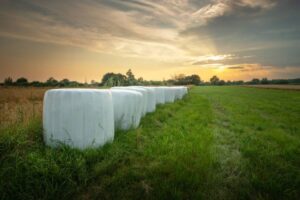As a farmer, you aim to provide the best quality forage for your livestock while minimising waste. And one key component in achieving this is proper storage and ensiling techniques. This is where silage film bale protection comes into play – a versatile and effective tool revolutionising forage preservation. From improving feed quality to reducing spoilage and increasing profits, silage film offers numerous benefits every farmer should take advantage of. In this article, we will delve into the various advantages of silage film and its impact on modern farming practices.
 As agriculture has advanced, so have the systems and processes involved in producing crops and raising livestock. One such development is the use of hay as a means of preserving feed for animals during times when fresh forage is scarce. Silage is fermented fodder created by storing grass or other crops in an airtight container to encourage anaerobic fermentation. The result is a nutritious food source that can be stored for long periods without spoiling. This means that farmers can provide their animals with a high-quality diet year-round, overcoming seasonal fluctuations in feed availability. As a result, silage has become increasingly important in modern farming practices, helping to ensure livestock health and well-being while improving overall efficiency and productivity.
As agriculture has advanced, so have the systems and processes involved in producing crops and raising livestock. One such development is the use of hay as a means of preserving feed for animals during times when fresh forage is scarce. Silage is fermented fodder created by storing grass or other crops in an airtight container to encourage anaerobic fermentation. The result is a nutritious food source that can be stored for long periods without spoiling. This means that farmers can provide their animals with a high-quality diet year-round, overcoming seasonal fluctuations in feed availability. As a result, silage has become increasingly important in modern farming practices, helping to ensure livestock health and well-being while improving overall efficiency and productivity.
For livestock owners and farmers, providing quality forage is crucial for the health and well-being of their animals. However, the problem of spoiled forage can have disastrous consequences, impacting both livestock nutrition and profitability. Spoiled forage can decrease dry matter intake and essential nutrient absorption, resulting in a decline in animal performance and poor health. Furthermore, the costs of discarding and replacing spoiled forage can significantly burden farmers. Therefore, it’s essential to implement effective management practices to prevent forage spoilage and maintain high-quality feed for livestock.
For centuries, traditional methods of storing forage, such as haymaking and hay, have been employed to preserve animal feed for the winter months. However, these methods come with certain limitations. One of the biggest challenges is the vulnerability of bales and stacks to moisture, leading to mould and decay. Besides, birds and rodents often damage exposed bales, reducing their nutritional value. Silage film bale protection has helped significantly reduce these issues by providing a protective barrier that limits air and water exposure. However, it is crucial to note that even with the film, proper bale protection is essential to ensure optimal preservation and animal health.
To ensure an abundant harvest for dairy farmers, making and storing high-quality silage is an essential practice. And to protect hay from spoilage, silage film is an indispensable ally. What is a silage film, you might ask? It’s a protective layer of plastic used to cover forage during storage, sealing it away from air and moisture and keeping it fresh for future use. This highly durable and puncture-resistant film acts as a shield, preventing the growth of bacteria, mould, and yeast that can cause nutritional loss, foul odours, and waste. Thanks to silage film, farmers can feel confident that their valuable silage will remain protected and ready to feed to their livestock, thereby maximising their profits and productivity.
Silage film is a game-changer in keeping your animal feed in top condition. This modern technology reduces feed waste and boosts nutrient retention for healthier and more productive livestock. The film provides a tight seal against external elements such as air and moisture, saving your silage from harmful bacteria and mould growth that could spoil your feed. In addition, silage film is cost-effective and convenient to use, making it a top choice for livestock farmers worldwide.
Silage film has proven a game-changer for farmers across the globe. The stretchy, adaptable material effectively protects silage bales from the elements and oxygen, preventing spoilage and extending the shelf-life of crops. The benefits of using silage film bale protection are numerous and far-reaching. It preserves feed quality and saves farmers time and money by eliminating the need for additional storage and handling costs. Moreover, its usage allows for better inventory management and helps reduce environmental waste. Silage film has significantly impacted farm operations, providing an excellent return on investment and advancing agricultural techniques towards a sustainable future.
